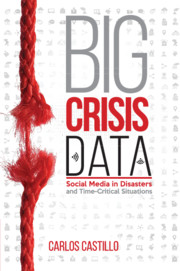Book contents
- Frontmatter
- Contents
- Preface
- Acknowledgments
- 1 Introduction
- 2 Volume: Data Acquisition, Storage, and Retrieval
- 3 Vagueness: Natural Language and Semantics
- 4 Variety: Classification and Clustering
- 5 Virality: Networks and Information Propagation
- 6 Velocity: Online Methods and Data Streams
- 7 Volunteers: Humanitarian Crowdsourcing
- 8 Veracity: Misinformation and Credibility
- 9 Validity: Biases and Pitfalls of Social Media Data
- 10 Visualization: Crisis Maps and Beyond
- 11 Values: Privacy and Ethics
- 12 Conclusions and Outlook
- Bibliography
- Index
- Terms and Acronyms
- Frontmatter
- Contents
- Preface
- Acknowledgments
- 1 Introduction
- 2 Volume: Data Acquisition, Storage, and Retrieval
- 3 Vagueness: Natural Language and Semantics
- 4 Variety: Classification and Clustering
- 5 Virality: Networks and Information Propagation
- 6 Velocity: Online Methods and Data Streams
- 7 Volunteers: Humanitarian Crowdsourcing
- 8 Veracity: Misinformation and Credibility
- 9 Validity: Biases and Pitfalls of Social Media Data
- 10 Visualization: Crisis Maps and Beyond
- 11 Values: Privacy and Ethics
- 12 Conclusions and Outlook
- Bibliography
- Index
- Terms and Acronyms
Summary
When faced with a sudden crisis, people quickly try to gather as much information as they can from the sources most immediately available to them: those in their immediate vicinity, friends and acquaintances via phone and texts, governments, nongovernment organizations, mass media such as radio and television, the Internet, and social media (Gao et al., 2014). Based on this information, they quickly take cover, flee, or act in a way that keeps them away from danger (Dynes, 1994).
Popular depictions of human response to crisis in movies and TV series tend to show widespread mayhem and panic. These scenes in “disaster movies” are plot devices, not very different from typical scenes in horror movies in which people irrationally run straight into danger (Mitchell et al., 2000). They are part of a long-standing myth that understands emergency management from a managerial perspective (Calhoun, 2004), and perpetuates the idea that disasters need to be policed because otherwise people will panic and riot.
As Palen (2014) emphasizes, an agenda of research about social media on disasters can uncover fascinating points if it avoids these misconceptions, and pays attention to the pro-social behavior of people during an emergency. Most people do not panic, but instead rapidly and effectively collect information, make decisions, and coordinate with others through a variety of channels. People affected by a disaster are the first to respond to it, often improvising complex rescue operations that save lives.
During a crisis, everybody involved – the public, the media, the government, emergency services, relief organizations, and others – try to quickly gain situational awareness. This is a complex process, which involves perceiving, comprehending, and being able to make predictions about the near future (Endsley, 1995; Vieweg, 2012). Gaining situational awareness is essentially a collective intelligence process that involves many actors interacting with a combination of various sources of information (Hutchins, 1995; Palen et al., 2010). Social media can contribute to situational awareness during a crisis, but handling its volume and complexity makes it impractical to be directly used by analysts.
This book is about how to use computing to help bridge this gap. This chapter explains what is the importance of social media for crisis management, exemplifying through recent crisis situations (§1.1). It provides some key concepts (§1.2) and describes information flows happening in social media during disasters (§1.3).
- Type
- Chapter
- Information
- Big Crisis DataSocial Media in Disasters and Time-Critical Situations, pp. 1 - 17Publisher: Cambridge University PressPrint publication year: 2016



